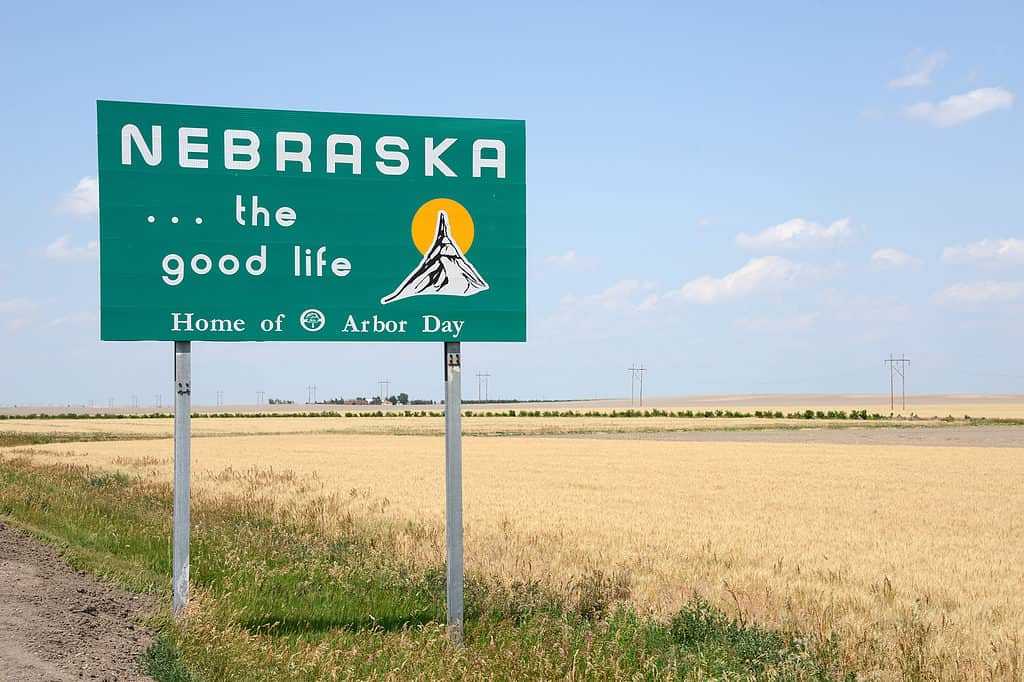It’s no secret that Nebraska is a big state. It’s the 16th largest in the country, with more than 77,000 square miles of land. Landowners’ choices today will determine what the state looks like in the coming years.
Who are the top players when deciding what the state’s future looks like? Let’s find out! Read on to discover the top landowners in Nebraska.
1. Federal Government — 549,346 Acres

The federal government owns 549,346 acres of Nebraska land, making it the largest land-owner in the state.
©Michael Kaercher/Shutterstock.com
The federal government oversees 549,346 acres in Nebraska. This means they are the top landowners in Nebraska. Since the entire state has 49.03 million acres, the federal government only has ownership over 1.12 % of Nebraska’s landmass. With these numbers, Nebraska has the sixth least amount of federal land ownership in the United States.
Four different agencies are working together to make land management possible. How do these federal agencies divide the workload for Nebraska? The majority of this acreage is overseen by the U.S. Forest Service, with 64.2%. This accounts for about 352,570 acres of Nebraska’s landmass. Next, the U.S. Fish and Wildlife Service comes in at 31.9%, and the Department of Defense at 1.8%. The National Park Service is also low at 1%, and the Bureau of Land Management is at 1%.
Sometimes state agencies work together with government programs to keep the parks running smoothly. Overall, the main goal for the lands is preservation. State parks are a great way to promote land preservation through education. When residents and visitors get in touch with Nebraska’s history, they’re more likely to help protect its future!
2. Ted Turner — 445,000 Acres

Ted Turner is one of the most prominent farmland owners in Nebraska.
©LBJ Library from Austin / public domain – License
Ted Turner owns 445,000 acres in Nebraska. He’s one of the most prominent farmland owners in the state. And it doesn’t look like he’s slowing down land acquisitions anytime soon. His ranching enterprise recently bought the 15,055-acre Kime Ranch.
Turner overpaid for the Kime Ranch at $725 per acre, a slightly higher rate than the going rate in that area of the Sand Hills. Shaen Kime, one of the ranch owners, said he could not comment on the purchase. He was, however, able to talk about the family’s ambitions. They plan on expanding their ranching operations and recently purchased a larger spread, the Red Deer Ranch, east of U.S. 83 in Cherry County.
Turner’s land holdings have allowed him to become one of the largest private owners in Nebraska. His seven holdings in Nebraska total over 440,000 acres — an area more than twice the size of Douglas County. A decade ago, he said his appetite for buying Nebraska grazing land was likely satisfied. But despite this statement, he has continued to buy more acreage in the state.
3. The Church of Jesus Christ of Latter-day Saints — 228,000 Acres

The headquarters of the Church of Jesus Christ of Latter-day Saints, which owns 228,000 acres of land in Nebraska.
©Sopotnicki/Shutterstock.com
The Church of Jesus Christ of Latter-day Saints (LDS) owns 228,000 acres in Nebraska. It recently purchased 88,000 acres in western Nebraska for $17.6 million, making it one of the state’s largest landowners.
The Church is exempt from the state’s ban on corporate farms and ranches because it is a nonprofit organization. They plan to use this land for grazing and hay production. Their most recent large purchase is also part of an effort to promote conservation practices on their land holdings in Nebraska.
Church President Gordon B. Hinckley sees farmland as a safe investment. Lamoreaux said that the land can feed people in a time of need. He also recognizes the need to protect the state’s beautiful landscape.
The Deseret Ranch is managing the LDS Church’s holdings in Nebraska. It’s one of the nation’s largest calf and cattle operations, covering 300,000 acres. Deseret Ranch promotes sustainable grazing and hay production practices on their land holdings throughout Nebraska. They’re actively implementing conservation initiatives to protect wildlife habitats and natural resources.
The church’s holdings are worth at least $2.3 billion, spread across states such as Nebraska, Montana, Florida, Texas, and Utah. The acreage owned by the Church stretches for miles, with many having tens of thousands of contiguous acres. The Church aims to have a high-quality product under environmentally sensitive conditions.
Any profits made off of their holdings fund missionary and humanitarian efforts worldwide. The Church’s land holdings in Nebraska allow visitors to explore the state’s history. They also provide a safe habitat for wildlife.
4. Bill Gates — 20,588 Acres

Bill Gates has been discretely purchasing farmland across the U.S. in states like Nebraska.
©Frederic Legrand – COMEO/Shutterstock.com
Bill Gates owns 20,588 acres in Nebraska. He’s the fourth richest person in the world and has more of a reputation for his programming skills rather than his love of the outdoors. However, he has been discretely purchasing a lot of farmland across the U.S.
He has so much land that now he’s the top private farmland owner in America. The billionaire’s Nebraska land holdings are spread out throughout several counties. Bill Gates is likely one of your neighbors if Cascade Investment Group or Cottonwood Ag Management owns the land.
Gate’s land purchases happen through a shell company, Cascade Investment. Cascade Investments invests in food-safety company Ecolab, used-car retailer Vroom, and Canadian National Railway. Cascade has invested in developing and proliferation of super crops.
Super crops are resistant to climate change and have higher-yield dairy cows. In addition, the Bill & Melinda Gates Foundation announced a $306 million grant program. The program will help promote sustainable agriculture among smallholder farmers. Specifically farmers in sub-Saharan Africa and South Asia.
The Gates Foundation’s agricultural initiative helps smallholder farmers adapt to climate change. Gates is an ardent believer in climate change. He believes strongly that reducing beef consumption is one of the best ways to reduce methane emissions from cattle. With this in mind, his ranching enterprise focuses more on conservation than profit. He has also proposed that his ranch serves as a research station to better understand climate change and how it affects the environment.
5. Nebraska Land Trust — 11,000 Acres
The Nebraska Land Trust oversees 11,000 acres in Nebraska. The land trust began in 2001 with a mission to protect agricultural, historical, and natural resources on land in Nebraska. It works in partnership with landowners looking to preserve their land for the benefit of future generations. Take a peek at the stunning landscapes for yourself! The Land Trust’s drone footage shows you a birds-eye view of Nebraska.
The trust has purchased or placed conservation easements all across the state. Conservation easements are voluntary agreements between landowners and the trust. They allow private land to remain in its natural state while still permitting certain activities. Permitable activities include things such as farming and ranching.
Do these conservation easements restrict landowners’ ability to sell or bequeath the land? No, but any transactions must comply with the terms of the agreement and keep all protected resources intact. The trust’s agreements also last perpetually, meaning they stay with the land even if it is sold or transferred.
Wildlife Conservation Efforts
Turner’s large estate is a great example of how good land stewardship can help conserve Nebraska’s wildlife habitats and grazing lands. By preventing development, the land can remain available for all critters. These animals play a vital role in maintaining healthy ecosystems.
What type of wildlife is benefiting from Turner’s well-kept lands? The state of Nebraska boasts an array of wildlife, including the beaver, bobcat, coyote, mink, mountain lion, and black bear. There’s also an array of birds, such as the bald eagle, sandhill crane, and bobwhite quail. The opossum, raccoon, and black-footed ferret make their home in Nebraska’s prairies.
Herbivores are also well represented here. The mountain plovers and least terns can be found nesting in the plains and prairies of Nebraska. White-tailed deer, mule deer, pronghorn antelope, elk, wild turkeys, and bighorn sheep are all part of the state’s wildlife population. Prairie dogs and cottontail rabbits add to the biodiversity here as well. Turner’s large estate is home to many of these species and provides important habitat for them to thrive.
About Nebraska’s Landscape
Conservation efforts keep Nebraska’s landscape as stunning as ever before. Geographically, Nebraska splits into two major areas. The Dissected Till Plains cover the eastern quarter of the state with its low hills and deposits of loess. Loess is windblown sediments left over from glaciers melting in this region at the end of the last Ice Age.
The Great Plains has a variety of landscapes. These include canyons, valleys, lakes, wetlands, and even the highest peak in the state, Panorama Point. The Sand Hills in central Nebraska is the largest expanse of sand dunes in North America. Another natural wonder of Nebraska is in the northwest: the Badlands. They feature some bizarrely shaped sandstone formations formed by erosion over time. You must check them out if you’re ever in the area.
Nebraska National Monuments and Historical Sites
Federal and state-managed lands allow the public to enjoy all sorts of historical sites. Some of the most popular ones include the Agate Fossil Beds and Scotts Bluff National Monument.
The Agate Fossil Beds have a rich history. In the 1890s, scientists began rushing to the spot, which eventually became the most significant Miocene Epoch mammal site. Of course, the Lakota Sioux had already made the discovery years earlier.
Then there’s the Scotts Bluff National Monument. It’s a large rock formation that travelers have used for thousands of years. Travelers, including Native Americans and settlers, on Oregon Trail. There are lots of interesting stories to be told at both sites!
Nebraska also has several historic trails, including the Lewis and Clark National Historic Trail. This trail winds nearly 4,900 miles through the homelands of more than 60 Tribal nations. It follows the outbound and inbound routes of the 1803-1806 Lewis and Clark Expedition from Pittsburgh to the Pacific Ocean. The trail provides a unique opportunity to explore the history and legacy of the expedition. Places like this allow visitors to discover the people, places, and stories that make up this important part of our nation’s past.
Nebraska National and State Parks
In addition to its historic sites and trails, Nebraska has five national parks and eight state parks.
The Homestead National Historical Park in Gage County, commemorating the Homestead Act of 1862, has 100 acres of restored tallgrass prairie.
The Niobrara National Scenic River in north-central Nebraska is home to Smith Falls, which has a drop of 63 feet, and the Fort Niobrara National Wildlife Refuge, where a herd of 300 bison and some elk are protected.
Indian Cave State Park, located along the Missouri River in southeast Nebraska, is a designated historic preservation area. It includes a prehistoric petroglyph cave and St. Deroin, a partly reconstructed village that features local architecture more than 150 years old. For information on the state’s other national and state parks go here.
Summary of the 5 Largest Landowners in Nebraska
Here is a list of the 5 largest landowners in the state of Nebraska:
| Rank | Landowner | Land Size |
|---|---|---|
| 1 | Federal Government | 549,346 acres |
| 2 | Ted Turner | 445,000 acres |
| 3 | The Church of Jesus Christ of Latter-day Saints | 228,000 acres |
| 4 | Bill Gates | 20,588 acres |
| 5 | Nebraska Land Trust | 11,000 acres |
Final Thoughts on the Top Landowners in Nebraska
Now you have a snapshot of the top landowners in Nebraska. Nebraska is a beautiful state with a diverse landscape. No matter where you go, chances are you’ll find a place to explore and learn about.
The land is owned by various groups, including Bill Gates, Ted Turner, the Nebraska Land Trust, and more! And the federal government does a great job managing the national parks system. The historical sites are educational, immersive, and unforgettable locations.
By helping protect the environment, these landowners are making an impact far beyond merely owning large tracts of land. With their help, we can ensure that future generations continue enjoying this great state’s beauty. So the next time you visit Nebraska, take some time to appreciate the land and its many owners. To learn more about the Cornhusker State, check out the articles below!
Who Are the Largest Landowners in the United States?

The Federal Government owns 640 million acres of U.S. lands, making it the largest landowner in the United States.
©Ultima_Gaina/iStock via Getty Images
There are two worth mentioning as relating to the largest landowners in the United States. The first is probably pretty obvious-the U.S. Government. Shared between the National Park Service, the Forest Service, the Bureau of Land Management, the Fish and Wildlife Service, and the Department of Defense, over 640 million acres of U.S. land are owned by the Federal Government. That’s roughly ⅓ of all the land in the United States, which averages out to a total of 2.3 billion acres.
The largest landowner in the United States other than the Federal Government is the Emmerson family, whose patriarch Red Emmerson founded Sierra Pacific Industries in Anderson, California. This company is focused on lumber production, operating a number of sawmills. The Emmerson family owns approximately 2,330,000 acres of land.
The other top largest landowners in the U.S. are:
- John Malone–2,200,000 acres (land committed to conservation)
- The Reed Family–2,100,000 acres (lumber production and forests)
- Ted Turner–2,000,000 acres (ranching and agricultural research)
- Stan Kroenke–1,627,500 acres (farmland, ranches, renewable energy)
The photo featured at the top of this post is © iStock.com/marekuliasz
Thank you for reading! Have some feedback for us? Contact the AZ Animals editorial team.







